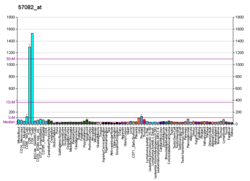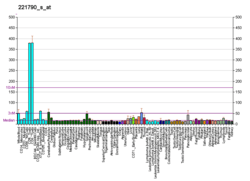Low-density lipoprotein receptor adapter protein 1
Low-density lipoprotein receptor adapter protein 1 is a protein that in humans is encoded by the LDLRAP1 gene.[5]
The protein encoded by this gene is a cytosolic protein which contains a phosphotyrosine binding (PTB) domain. The PTB domain has been found to interact with the cytoplasmic tail of the LDL receptor. Mutations in this gene lead to LDL receptor malfunction and cause the disorder autosomal recessive hypercholesterolaemia.[5]
Interactions
LDLRAP1 has been shown to interact with AP2B1[6][7] and LRP2.[8]
gollark: the quick brown fox jumped over the lazy dog
gollark: the quick brown fox jumped over the lazy dog
gollark: the quick brown fox jumped over the lazy dog
gollark: the quick brown fox jumped over the lazy dog
gollark: the quick brown fox jumped over the lazy dog
References
- GRCh38: Ensembl release 89: ENSG00000157978 - Ensembl, May 2017
- GRCm38: Ensembl release 89: ENSMUSG00000037295 - Ensembl, May 2017
- "Human PubMed Reference:". National Center for Biotechnology Information, U.S. National Library of Medicine.
- "Mouse PubMed Reference:". National Center for Biotechnology Information, U.S. National Library of Medicine.
- "Entrez Gene: LDLRAP1 low density lipoprotein receptor adaptor protein 1".
- Rual JF, Venkatesan K, Hao T, Hirozane-Kishikawa T, Dricot A, Li N, Berriz GF, Gibbons FD, Dreze M, Ayivi-Guedehoussou N, Klitgord N, Simon C, Boxem M, Milstein S, Rosenberg J, Goldberg DS, Zhang LV, Wong SL, Franklin G, Li S, Albala JS, Lim J, Fraughton C, Llamosas E, Cevik S, Bex C, Lamesch P, Sikorski RS, Vandenhaute J, Zoghbi HY, Smolyar A, Bosak S, Sequerra R, Doucette-Stamm L, Cusick ME, Hill DE, Roth FP, Vidal M (Oct 2005). "Towards a proteome-scale map of the human protein-protein interaction network". Nature. England. 437 (7062): 1173–8. Bibcode:2005Natur.437.1173R. doi:10.1038/nature04209. PMID 16189514.
- He, Guocheng; Gupta Sarita; Yi Ming; Michaely Peter; Hobbs Helen H; Cohen Jonathan C (Nov 2002). "ARH is a modular adaptor protein that interacts with the LDL receptor, clathrin, and AP-2". J. Biol. Chem. United States. 277 (46): 44044–9. doi:10.1074/jbc.M208539200. ISSN 0021-9258. PMID 12221107.
- Nagai, Masaaki; Meerloo Timo; Takeda Tetsuro; Farquhar Marilyn Gist (Dec 2003). "The adaptor protein ARH escorts megalin to and through endosomes". Mol. Biol. Cell. United States. 14 (12): 4984–96. doi:10.1091/mbc.E03-06-0385. ISSN 1059-1524. PMC 284800. PMID 14528014.
Further reading
- Barbagallo CM, Emmanuele G, Cefalù AB, et al. (2003). "Autosomal recessive hypercholesterolemia in a Sicilian kindred harboring the 432insA mutation of the ARH gene". Atherosclerosis. 166 (2): 395–400. doi:10.1016/S0021-9150(02)00379-9. PMID 12535754.
- Garcia CK, Wilund K, Arca M, et al. (2001). "Autosomal recessive hypercholesterolemia caused by mutations in a putative LDL receptor adaptor protein". Science. 292 (5520): 1394–8. Bibcode:2001Sci...292.1394G. doi:10.1126/science.1060458. PMID 11326085.
- Arca M, Zuliani G, Wilund K, et al. (2002). "Autosomal recessive hypercholesterolaemia in Sardinia, Italy, and mutations in ARH: a clinical and molecular genetic analysis". Lancet. 359 (9309): 841–7. doi:10.1016/S0140-6736(02)07955-2. PMID 11897284.
- Al-Kateb H, Bähring S, Hoffmann K, et al. (2002). "Mutation in the ARH gene and a chromosome 13q locus influence cholesterol levels in a new form of digenic-recessive familial hypercholesterolemia". Circ. Res. 90 (9): 951–8. doi:10.1161/01.RES.0000018002.43041.08. PMID 12016260.
- He G, Gupta S, Yi M, et al. (2003). "ARH is a modular adaptor protein that interacts with the LDL receptor, clathrin, and AP-2". J. Biol. Chem. 277 (46): 44044–9. doi:10.1074/jbc.M208539200. PMID 12221107.
- Wilund KR, Yi M, Campagna F, et al. (2003). "Molecular mechanisms of autosomal recessive hypercholesterolemia". Hum. Mol. Genet. 11 (24): 3019–30. doi:10.1093/hmg/11.24.3019. PMID 12417523.
- Mishra SK, Watkins SC, Traub LM (2003). "The autosomal recessive hypercholesterolemia (ARH) protein interfaces directly with the clathrin-coat machinery". Proc. Natl. Acad. Sci. U.S.A. 99 (25): 16099–104. Bibcode:2002PNAS...9916099M. doi:10.1073/pnas.252630799. PMC 138571. PMID 12451172.
- Eden ER, Patel DD, Sun XM, et al. (2003). "Restoration of LDL receptor function in cells from patients with autosomal recessive hypercholesterolemia by retroviral expression of ARH1". J. Clin. Invest. 110 (11): 1695–702. doi:10.1172/JCI16445. PMC 151635. PMID 12464675.
- Strausberg RL, Feingold EA, Grouse LH, et al. (2003). "Generation and initial analysis of more than 15,000 full-length human and mouse cDNA sequences". Proc. Natl. Acad. Sci. U.S.A. 99 (26): 16899–903. Bibcode:2002PNAS...9916899M. doi:10.1073/pnas.242603899. PMC 139241. PMID 12477932.
- Jones C, Hammer RE, Li WP, et al. (2003). "Normal sorting but defective endocytosis of the low density lipoprotein receptor in mice with autosomal recessive hypercholesterolemia". J. Biol. Chem. 278 (31): 29024–30. doi:10.1074/jbc.M304855200. PMID 12746448.
- Harada-Shiba M, Takagi A, Miyamoto Y, et al. (2003). "Clinical features and genetic analysis of autosomal recessive hypercholesterolemia". J. Clin. Endocrinol. Metab. 88 (6): 2541–7. doi:10.1210/jc.2002-021487. PMID 12788851.
- Nagai M, Meerloo T, Takeda T, Farquhar MG (2004). "The adaptor protein ARH escorts megalin to and through endosomes". Mol. Biol. Cell. 14 (12): 4984–96. doi:10.1091/mbc.E03-06-0385. PMC 284800. PMID 14528014.
- Ota T, Suzuki Y, Nishikawa T, et al. (2004). "Complete sequencing and characterization of 21,243 full-length human cDNAs". Nat. Genet. 36 (1): 40–5. doi:10.1038/ng1285. PMID 14702039.
- Michaely P, Li WP, Anderson RG, et al. (2004). "The modular adaptor protein ARH is required for low density lipoprotein (LDL) binding and internalization but not for LDL receptor clustering in coated pits". J. Biol. Chem. 279 (32): 34023–31. doi:10.1074/jbc.M405242200. PMID 15166224.
- Gerhard DS, Wagner L, Feingold EA, et al. (2004). "The status, quality, and expansion of the NIH full-length cDNA project: the Mammalian Gene Collection (MGC)". Genome Res. 14 (10B): 2121–7. doi:10.1101/gr.2596504. PMC 528928. PMID 15489334.
- Canizales-Quinteros S, Aguilar-Salinas CA, Huertas-Vázquez A, et al. (2005). "A novel ARH splice site mutation in a Mexican kindred with autosomal recessive hypercholesterolemia". Hum. Genet. 116 (1–2): 114–20. doi:10.1007/s00439-004-1192-9. PMID 15599766.
- Mishra SK, Keyel PA, Edeling MA, et al. (2005). "Functional dissection of an AP-2 beta2 appendage-binding sequence within the autosomal recessive hypercholesterolemia protein". J. Biol. Chem. 280 (19): 19270–80. doi:10.1074/jbc.M501029200. PMID 15728179.
- Sirinian MI, Belleudi F, Campagna F, et al. (2006). "Adaptor protein ARH is recruited to the plasma membrane by low density lipoprotein (LDL) binding and modulates endocytosis of the LDL/LDL receptor complex in hepatocytes". J. Biol. Chem. 280 (46): 38416–23. doi:10.1074/jbc.M504343200. PMID 16129683.
- Rual JF, Venkatesan K, Hao T, et al. (2005). "Towards a proteome-scale map of the human protein-protein interaction network". Nature. 437 (7062): 1173–8. Bibcode:2005Natur.437.1173R. doi:10.1038/nature04209. PMID 16189514.
This article is issued from Wikipedia. The text is licensed under Creative Commons - Attribution - Sharealike. Additional terms may apply for the media files.





